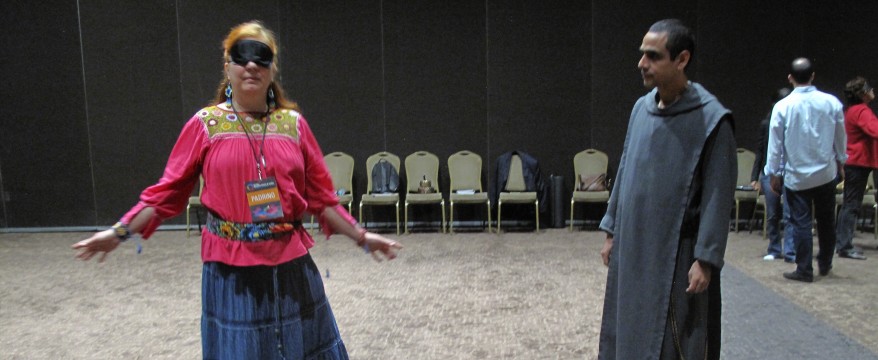La Experiencia Impulsa
INSTALLMENT 2 of 3:
AARON’S KEYNOTE WAS STILL IN THE AIR two days later, on Sunday morning, when over 40 of the conference participants showed up for our breakout session.
We’d set up the conference room chairs in two concentric circles, with a Spanish version of our learning model on an easel. I translated for Aaron as he welcomed the participants. Many of them, we learned, were school teachers, but there was also a friar, a nun who ran a Catholic school, a relationship coach, an accomplished visual artist, and two members of an influential NGO seeking to transform schools and education across Mexico.
We explained that we were going to move into an experience that would give them a deeper understanding of the Academy’s learning model, then asked them to stand, move their chairs to the edges of the room, and find a partner. One partner would be the guide, the other—who would be blindfolded—would be the “explorer.” From that point on, we would be in total silence.
As our team handed out the blindfolds, I took a breath. Even now, after having facilitated the Impulse Exercise several times at the Academy, there’s a part of me that always wonders, “Will the people do it? Will they put on the blindfolds? Why didn’t we just prepare a clever Powerpoint?”
But the same thing happened in Mexico that always happens here: These people were hungry for learning based in experience. The moment we turned on the music (a slow opening to an Aaron Copland concerto), they dove into the experience con gusto—with joy.
Silently, blindfolded explorers “followed their impulses.” They walked, or sat, or danced, or twirled, or did nothing at all. The sighted guides made sure their partners were safe, but also played with how much direction to give. What was it like to stand back and observe intently? What was it like to try to somehow amplify the explorer’s impulses with light touch? And what was it like to take hold of the explorer’s shoulders and march her around the room?
The music came to a close, nearly 45 minutes later, after both partners had played explorer and guide, all in silence. We then invited the partners to share with each other what they had noticed and felt, and gathered for a final circle.
As with Aaron’s keynote, there was a palpable excitement in the room, a sense of discovery. Something had been awakened in the participants, new understandings about their own patterns and beliefs as teachers and learners. Interestingly, a few participants spoke about the gift in letting go of one’s impulses, making room and allowing one’s self to be guided. Others immediately saw how they would apply this work to their classrooms, how they would view their children’s learning in a new light.
We lingered in the conference hallway long after the workshop closed, sharing hugs, ideas, and email addresses with these wonderful men and women. It became clear to us, as we made our way to the entrance, back to our taxis and plane flights home, that the Academy’s work is not nearly as “peripheral” to the mainstream as we sometimes think. In Monterrey, at least, people are asking the same questions we are. They’re searching, like us, for ways to wake up as learners and human beings, to stay alive. They too want to find ways to live that embrace what the poet Ferlenghetti described as a “perpetual rebirth of wonder.”
As one participant would email us later, “the most important thing, as your Academy points out, is that love of learning… can lead us to break our own internal barriers and foresee the freedom to be who we really are.” Así será, amiga. So it will be.


